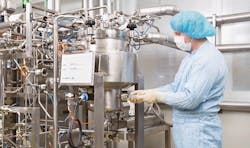The pharmaceutical space is an industry in transition. To be successful in the past meant coming up with the next blockbuster drug. But with generic versions, the emerging customized drug market, and elevated cost and quality pressures, there’s a lot more to do these days. And all eyes are on the batch processes on the plant floor which, to date, have been the tried-and-true approach to regulatory compliance. But now batch appears to be the bottleneck to manufacturing innovation.
For pharmaceutical companies to compete in the future they will need to make more drugs that adhere to the same strict cost constraints and quality standards. To do that, pharmas are ripping a page from the chemical and oil and gas manufacturing playbooks and moving toward continuously run processes and process analytical technologies (PAT).
The move from mixing ingredients in separate batches to adopting a continuous process approach is gaining traction because it could cut operational expense, shorten production times, and create a quality-by-design model for manufacturers. It also helps that the U.S. Food and Drug Administration (FDA) supports a move to continuous manufacturing (CM). In a 2012 report, the FDA outlined the advantages of CM, including: Integrated processing with fewer steps; smaller equipment and facilities with more flexible operations and lower capital costs; and the ability to perform real-time on-line monitoring and control.
The problem is, this is a completely new way of making things for these companies. Changing operating processes—many of which have been in place since the 1950s—and moving to a modern manufacturing set up, requires new technology, new tools, and new talent.
Here are the challenges: An increased need to understand system integration and the interaction between unit operations. It also requires interfacing between different lots of raw materials, and having visibility into all of the system data in order to manage it. This brings up the need for analytical tools for control systems, and the need for sampling to ensure product quality along the continuous path. Plus, companies will have to make sure operators have the right skillset and complete understanding of how the entire process works.
Some pharma companies are up for the challenge. A recent Wall Street Journal article noted that GlaxoSmithKline PLC, Johnson & Johnson and Novartis AG are among the companies building facilities to make drugs differently. In addition, Biotechs BioMarin Pharmaceutical Inc. and Vertex Pharmaceuticals Inc. are moving in this direction as well.
The WSJ article notes that Novartis is building a line at a Swiss plant that would make drugs continuously from the start of ingredient production through the end of coating tablets. Quality is increased by making any necessary corrections throughout production, not just after a batch is finished. And, as a result, industry experts say companies can save an estimated 30% or more in operating costs.
Novartis, actually, has been at this for a long time. In 2007 it gave MIT $65 million and formed the Novartis-MIT Center for Continuous Manufacturing. The partnership kick-started a 10-year research program aimed at revolutionizing the way drugs are made. That is, the move from batch processing to a continuous high-tech process. Now, it seems, Novartis is on its way to delivering on the vision.
While the WSJ reported that the build out of continuous process manufacturing plants will cost less than the traditional drug-making plants because it will require less equipment and space, I’ve yet to hear about how much it will cost a company for the technology deployment.
This is a completely new way of manufacturing. A real rip and replace of legacy equipment. That’s not going to be cheap. And manufacturers following in the footsteps of these pioneers of continuous processing for pharma will require a lot of help along the way. These plants will need to be designed. New control systems will be put in place, data management and intelligent monitoring tools, too, need to be part of the plan. And let’s not forget the people. Workforce development will be just as important to the success of the plant.
Lots to do. The next few years should be an interesting place for the pharmaceutical space.
About the Author
Stephanie Neil
Editor-in-Chief, OEM Magazine

Leaders relevant to this article:
